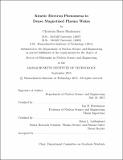| dc.contributor.advisor | Ian H. Hutchinson. | en_US |
| dc.contributor.author | Haakonsen, Christian Bernt, 1985- | en_US |
| dc.contributor.other | Massachusetts Institute of Technology. Department of Nuclear Science and Engineering. | en_US |
| dc.date.accessioned | 2016-07-18T19:11:02Z | |
| dc.date.available | 2016-07-18T19:11:02Z | |
| dc.date.copyright | 2015 | en_US |
| dc.date.issued | 2015 | en_US |
| dc.identifier.uri | http://hdl.handle.net/1721.1/103664 | |
| dc.description | Thesis: Ph. D., Massachusetts Institute of Technology, Department of Nuclear Science and Engineering, 2015. | en_US |
| dc.description | This electronic version was submitted by the student author. The certified thesis is available in the Institute Archives and Special Collections. | en_US |
| dc.description | Cataloged from student-submitted PDF version of thesis. | en_US |
| dc.description | Includes bibliographical references (pages 135-143). | en_US |
| dc.description.abstract | Flow past an obstacle by dense magnetized plasma, having both Debye-length and gyroradii smaller than the obstacle, is explored using particle-in-cell (PIC) simulations. These simulations are relevant to a wide range of physical settings, ranging from the moon in the (supersonic) solar wind to Mach probes in (subsonic) tokamak plasmas. For supersonic flow, the evolution of the resulting elongated wake is captured with high-resolution 1D simulations, using kinetic electrons with realistic mass. This leads to the discovery of a novel wake phenomenon, where electron holes spawned from a narrow dimple in the velocity-distribution grow to large velocity extents, leading to disruption of the ion beams present in the wake. Those beams are the result of shadowing by the obstacle, which also occurs for electrons in what is a less elongated forewake, lying outside the traditional wake. This forewake is explored with 2D simulations, also using kinetic electrons with realistic mass, and it is found that drift-energization near the obstacle can significantly modify the electron distribution in some regions. Most significantly, drift-energization appears to quite robustly generate a slope-reversal of the electron velocity-distribution, which is expected to become unstable; this phenomenon thus provides a novel drive for forewake instability. 2D simulations at subsonic flow are used in an initial investigation of whether kinetic electron effects also impact the stability of wakes at slower flow. It is found that kinetic electrons do trigger disruption of the ion beams in the wake, as in the (supersonic) 1D simulations, but the hole-growth phenomenon cannot be conclusively implicated because a highly artificial electron mass needed to be used. In summary, the understanding of kinetic electron effects as dense magnetized plasma flows past an obstacle is greatly enhanced, uncovering a number of novel phenomena with implications for the stability of the resulting wake and forewake | en_US |
| dc.description.statementofresponsibility | by Christian Bernt Haakonsen. | en_US |
| dc.format.extent | 143 pages | en_US |
| dc.language.iso | eng | en_US |
| dc.publisher | Massachusetts Institute of Technology | en_US |
| dc.rights | M.I.T. theses are protected by copyright. They may be viewed from this source for any purpose, but reproduction or distribution in any format is prohibited without written permission. See provided URL for inquiries about permission. | en_US |
| dc.rights.uri | http://dspace.mit.edu/handle/1721.1/7582 | en_US |
| dc.subject | Nuclear Science and Engineering. | en_US |
| dc.title | Kinetic electron phenomena in dense magnetized plasma wakes | en_US |
| dc.type | Thesis | en_US |
| dc.description.degree | Ph. D. | en_US |
| dc.contributor.department | Massachusetts Institute of Technology. Department of Nuclear Science and Engineering | |
| dc.identifier.oclc | 953414548 | en_US |
